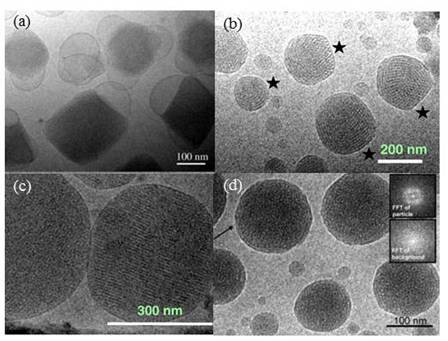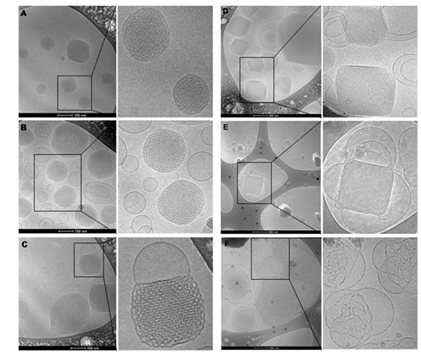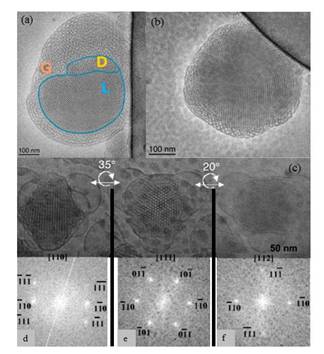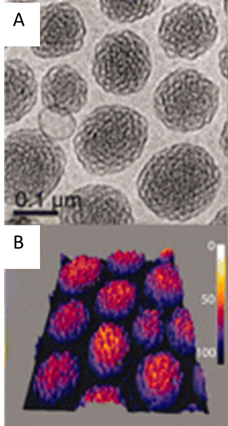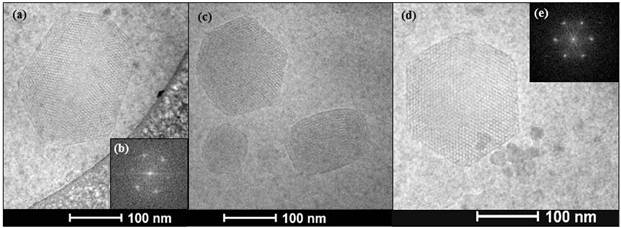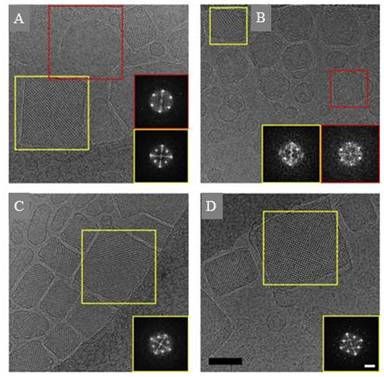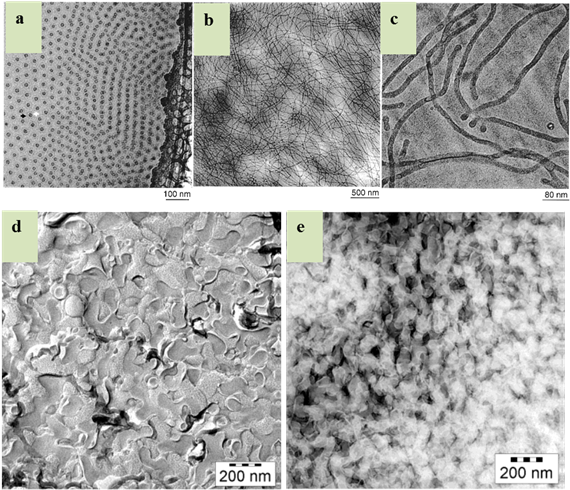Cryo-transmission electron microscopy (Cryo-TEM), and its technological variations thereof, have become a powerful tool for detailed morphological characterization and 3D tomography of soft lipid and polymeric nanoparticles as well as biological materials such as viruses and DNA without chemical fixation. Here, we review and discuss recent advances in Cryo-TEM analysis of lipid-based drug nanocarriers with particular emphasis on morphological and internal nanostructure characterization of lyotropic liquid crystalline nanoparticles such as cubosomes and hexosomes.
1.
Introduction
The textural, sensorial and functional quality attributes of Cheddar cheese evolve during the aging of the cheese and reflect the combined influence of the dynamic microbiological, biochemical, and physico-chemical activities and reactions [1,2,3,4]. The main three biochemical cascades that occur during cheese aging are glycolysis, lipolysis and proteolysis [2,5,6]. Among these, proteolysis is considered the most important and most complex series of events [2,7,8]. The proteolytic cascade that occurs during cheese aging consists of enzymatic degradation of the casein constituents of the cheese matrix and the accumulation of a very heterogeneous population of peptides of different molecular weights and free amino acids [5,6,9,10]. A certain proportion of these free amino acids becomes involved in catabolic reactions the products of which have a major impact on the flavor and aroma characteristics of the cheese [5,10,11]. The type, rate, and extent of the proteolytic activities that occur during the aging of Cheddar cheese are governed by combined effects of the type and concentration of proteolytic agents that are included in the curd, curd composition, and the aging conditions [2,5,6]. The proteolytic agents in Cheddar cheese produced with pasteurized milk include the indigenous proteolytic enzymes of milk, plasmin and cathepsin D, heat-stable proteolytic enzymes of somatic cells and psychrotrophic bacteria, the proportion of milk coagulant that is retained in the curd, as well as the proteolytic enzymes of starter- and non-starter lactic acid bacteria [6,7,12,13,14,15,16,17,18]. The dynamics of the proteolytic activities during cheese aging are governed by the combined effects of curd composition, pH, salt-in-moisture (S/M), ionic strength and ionic composition [2,5,19,20]. Cheddar cheese is commonly aged isothermally at 6-8 ℃ [21] and the effect of aging temperature on proteolysis during cheese aging has been recognized and has been exploited as an effective means for accelerating cheese aging [6,21,22,23,24,25,26,27,28,29,30,31]. For example, Cheddar cheese that had been aged at different time-at-temperature programs at temperatures ranging from 7 to 20 ℃ exhibited significant time-at-temperature-dependent differences in microstructural, textural, and sensorial characteristics that reflected the effect of the aging conditions on the extent of proteolysis [21,26]. Aging Cheddar cheese at an elevated temperature allows enhancing its aging process, however, it can also lead to the evolution of microbiological, textural and sensorial defects [6,30,31]. It has been suggested that an accelerated aging temperature of 12 ℃ is optimal in order to limit adverse effects of high aging temperature on proteolysis and, consequently, texture and flavor [23,24,30]. The information about the effects of non-isothermal aging conditions on proteolysis is relatively limited and has been established for cheeses that had been subjected to temperatures higher than 10 ℃ [21,26]. Mitigating challenges that are associated with disrupt supply chain are likely to require modulating the rate of cheese aging without introducing a major acceleration effect that are known to lead to the evolution of textural and sensorial defects [24]. Introducing such capabilities requires developing information about the effects of relatively small changes in aging temperature on proteolysis. Additionally, it has to be recognized that, unfortunately, maintaining isotropic temperature distribution in cheese aging rooms is a common challenge and cheeses that are stored at different domains in a given aging room experience different time-at-temperature conditions. Recently, it has been demonstrated that both an electronic nose and consumers could detect sensorial differences between Cheddar cheeses that had been aged at 10 ℃ and 7 ℃ [27]. Data about the extent to which small variations in aging temperature affect proteolysis during aging of Cheddar cheese has been established only to a very limited extent. The objective of our research was to age FF and RF Cheddar cheeses at different time-at-temperature aging regimes ranging from 5 to 8 ℃ and to investigate the effects of these conditions on proteolysis during 6 months of aging.
2.
Materials and methods
2.1. Cheeses
Ten-day old full-fat (FF) and reduced-fat (RF) Cheddar cheeses were delivered, at 4-6 ℃, to our laboratory. Both cheeses were manufactured on the same day from the same batch of pooled milk, using the same coagulant and starter cultures, at a California creamery. Immediately upon arrival, the cheeses were cut into 1 kg portions that were then vacuumed packaged in BK1 Cryovac plastic bags (W.R. Grace Co., Duncan, SC). The packaged cheeses were aged for 180 days at different isothermal and non-isothermal time-at-temperature programs (Table 1). Cheeses were denoted according to their type (FF or RF) and the time-at-temperature program at which they were aged. For example, FF5 and RF8 were full-fat and reduced-fat Cheddar cheeses that were aged for 180 at 5 and 8 ℃, respectively. Similarly, FF585AC was a full-fat Cheddar cheese that was aged for 30 days at 5 ℃ than for 60 days at 8 ℃, and for additional 90 days at 5 ℃.
2.2. Analyses
2.2.1. Cheese composition
The moisture, protein, fat, ash and salt contents of the FF and RF cheeses were determined at a cheese age of 10 days according to the Standard Methods of analyzing milk and dairy products [32]. Moisture content was determined gravimetrically, after vacuum drying for 12 h [32]. Protein content was determined according to the macro-Kjeldahl method, using a nitrogen-to-protein conversion factor of 6.38 [32]. Fat content was determined according to the Rose-Gotlieb method and ash content was determined gravimetrically after incineration in a muffle furnace at 550 ℃ [32]. Salt content of the cheeses was determined according to the Volhard method [32]. The results of the latter analysis and those of the afore-mentioned moisture content analysis were used to calculate the concentration (%) of salt in the aqueous phase of the cheese, that is salt-in-moisture (S/M). The pH of the investigated cheeses was determined using an Orion Star pH meter equipped with a spear-tip glass electrode (Thermo- Fisher Scientific). In all cases, duplicate samples were analyzed in triplicate (N X n = 6).
2.2.2. Cheese fractionation
The effects of the investigated aging programs on proteolysis during cheese aging were investigated by monitoring the accumulation of three cheese-N fractions that has been indicated as cheese aging indices [7,33]. These consisted of the cheese-N fraction that was soluble at pH 4.6 (pH 4.6SN), the Cheese-N fraction that was soluble in 12% tri-chloroacetic acid (12TCASN) and that Cheese-N fraction that was soluble in 5% Phospho-tungstic acid (5PTASN) [7,33,34,35,36]. The investigated cheese fractions were prepared as previously described, with some modifications [9,33,34,35]. Briefly, grated cheese (200 g) was mixed with 400 mL of de-ionized water (Millipore, 18.2 MW.cm) and the mixture was homogenized for 3 min using a model 34BL97 Warning Blender (Dynamic Corp., New Hartford, CT) operated at maximum speed. The homogenate was stirred for 30 min at 25 ℃ and was then centrifuged for 20 min at 3000 X g. The supernatant was filter through a layer of glass wool (Fisher Scientific, Fair Lawn, NJ) and the pH of the filtrate was adjusted to pH 4.6 using 1.4N HCl. The mixture was centrifuged for 20 min at 3000 X g and, the supernatant was filtered through a Number 1 Whatman filter paper (Fisher Scientific, Fair Lawn, NJ). The filtrate was denoted as pH 4.6-soluble N (pH 4.6SN). A portion (45 mL) of the pH4.6SN fraction was mixed with 15 mL of 48% (w/v) TCA (Sigma Chemical Co., St. Luis, MO). The mixture was incubated at 25 ℃ for 12 h and was then centrifuged for 20 min at 3000 X g. The supernatant was filtered through No1 Whatman filter paper and the filtrate was denoted 12%TCA-soluble N (12TACSN). The cheese N fraction that was soluble in 5% PTA was preparing by mixing 50 mL of the 4.6SN fraction with 3.95 mL of H2SO4 and 15 mL of 33.3% (w/w) PTA (Sigma Chemical Co. St. Luis, MO). After incubation for 12 h at 25 ℃, the mixture was centrifuged at 3000 X g for 20 min, the supernatant was filtered through a No1 Whatman filter paper and the filtrate was denoted as 5% PTA-soluble N fraction (5PTASN). In all cases, the N content of the afore-mentioned fractions was determined by the macro-Kjeldhal analysis and the results were expressed as percent of total cheese N. In all cases, duplicate samples were analyzed in triplicates (N x n = 6).
2.2.3. Statistical analysis
The significance of the resulted was challenged, at p < 0.05, by ANOVA using the SigmaStat software (Jandel Scientific Software, San Rafael, CA, USA). Line equations were established using the trendline tools included in Microsoft Excel software package (Microsoft Office Professional Plus 2016 (Microsoft, Redmond, WA, USA).
3.
Results and discussion
3.1. Cheese composition
The composition of the 10d old cheeses is detailed in Table 1. The fat and protein content of the RF cheese was about 33% lower and 28% higher than that of the FF Cheddar, respectively (Table 1). The pH of the two cheeses did not differ significantly (p > 0.05) and the S/M content of the RF cheese was significantly higher (p < 0.05) than that in the FF cheese. In the case of Cheddar cheese, the S/M is adjusted to be at least 4.5%. A lower S/M can promote an excessive extent of proteolysis that, in many cases can lead to the accumulation of bitter peptide originating mainly from β-CN [37]. Reduced- and low-fat Cheddar cheeses have been reported to be prone to the evolution of higher-than desired lactic acid content during cheese making [38]. The similar pH of the cheeses at 10 days of age suggested that the RF cheese had been produced at conditions that prevented the excessive evolution of the pH. Alternatively, the similar pH can be explained in light of the higher protein content of the RF cheese that presented a higher buffering capacity than that in the FF cheese [9,38].
At a cheese age of 10 d, prior to being subjected to the different time-at-temperature aging conditions, the proportion of pH 4.6SN in the FF cheese was 14.6% higher than that in the RF cheese (Table 2). The proportions of the 12TCASN and of the 5PTASN in the 10d old FF Cheddar was 21.3 and 23.1% higher than that in the 10d old RF cheese, respectively (Table 2). Results thus indicated that overall, at the age of 10 days, the FF Cheddar exhibited a higher extent of proteolysis than that RF cheese. Because both cheeses were manufactured from the same batch of milk, this result can be probably attributed to the lower S/M of the FF cheese that allowed a higher extent of mainly primary proteolysis during the first 10 days following cheese making [9,39].
3.2. Effects of aging conditions on proteolysis
3.2.1. General
The results (Tables 3-9) have to be assessed in light of the different proteolytic activities that occur at different stages of the aging process. In general, at any given time, the level of each of the investigated cheese fractions represented the overall balance between proteolytic events that continuously hydrolyzed the cheese caseins, throughout the 180 aging days, and the involvement of free amino acids from the pool of the accumulated proteolytic products, in catabolic reactions [10,36]. Changes, with aging time, in the level of the accumulation of the investigated fractions represented the manifestation of different enzymatic and microbiological activities at different stages of the aging process as well as the effects of cheese composition and aging conditions on these events [2,5]. At early stages of the aging, proteolysis is mainly governed by the activity of the residuals of the coagulant that have been retained in the curd, plasmin, heat-stable proteases that are associated with somatic cells and psychrotrophic bacteria, and the extracellular, cell envelope-associated proteinase of Lactococccus [2,7]. At later stages, after the starter and non-starter lactic acid bacteria undergo autolysis, proteolytic products that have accumulated inside the bacterial cells as well as the microbial proteases and peptidases are released into the curd [7,11,40]. The activity of the latter becomes a significant contributor to the proteolytic cascade that result in the continuous accumulation of a very heterogeneous population of peptides and free amino acids, pending the consumption of the cheese [5,7,8,10,11].
3.2.2. Isothermal aging
The two isothermal aging programs to which the cheeses were subjected differed by only 3 ℃ and both temperatures were below 10 ℃. At both isothermal aging programs, the proportion of the pH 4.6SN in both FF and RF cheeses increased with aging time and in all cases its level in the cheeses was proportionally related to the aging temperature (Tables 4 and 5). The changes in the pH 4.6SN with aging time could be best described (R2 = 0.9867-0.9938) by polynomial expressions (Table 3), similar to what has been earlier reported for FF and LF Cheddar cheese [33]. The observed changes in the level of the accumulated pH 4.6SN reflected the overall balance between the extent of primary proteolysis and secondary proteolytic reactions as well as the catabolism of free amino acids [7,11]. After 60, 120 and 180 days, the proportion of pH 4.6SN in the FF8 cheese was about 13.5, 24.9, and 31.3% higher than that in the FF5 cheese, respectively (Table 4). Similarly, in the RF cheeses (Table 5), after 60, 120 and 180 days, the proportion of pH 4.6SN in the cheeses that had been aged at 8 ℃ was 34.8, 27.1, and 28.6%, higher than that in the RF cheeses that had been aged at 5 ℃, respectively. For a given aging time, the differences between FF and RF cheeses in the level of the pH 4.6SN fraction ranged from 4.4 to 20% and from 1.7 to 14.6%, for cheeses aged at 5 ℃ and 8 ℃, respectively (Tables 4 and 5). Results thus indicated that the effect of aging temperature on the extent of proteolytic activities was greater than the effect of cheese composition.
The changes with aging time in the proportion of the 12TCASN in the isothermally-aged FF and RF cheeses are depicted in Tables 6 and 7, respectively, and the polynomial line equations that best describe these changes (R2 = 0.961-0.9945) are presented in Table 3. The levels of 12TCASN that accumulated in the FF and RF cheeses during aging at 8 ℃ was 1.10-1.50 and 1.29-1.39 times higher than that in the cheeses that were aged at 5 ℃, respectively (Tables 6 and 7). During the first 60 days of aging at 5 ℃, the proportion of 12TCASN that accumulated in the FF cheese was 1.21-1.44 times higher than that accumulated in the RF cheese, however, at a longer aging time, the levels of the 12TCASN differed only slightly between the FF and the RF cheeses (Tables 6 and 7). The accumulation of the 5PTASN fraction was proportionally related to the aging time and the polynomial expressions that best describe (R2 = 0.9928-0.9983) the changes in this fraction with aging time are presented in Table 3. The accumulation of 5PTASN in the RF8 cheese was 1.28-1.79 times higher than that accumulated in the RF5 cheese (Table 9). Throughout the first 120 aging days, the level of 5PTASN in the FF8 cheese differed by less than 10% from that accumulated at FF5 cheese. However, after 180 days, the level of the 5PTASN in the FF8 cheese was 1.45 times higher than that in the FF5 cheese (Tables 8 and 9). The differences in the level of the 5PTASN that accumulated in the FF5 and FF8 cheese varied by 23-63% and by 6.2-16.6% from that in the RF5 and RF8 cheeses, respectively (Tables 8 and 9). The results of the isothermal aging indicated the significant effect that a 3 ℃ difference in aging temperature had on the accumulation of all the investigated cheese-N fractions. The results thus indicated that a 3 ℃ difference in aging temperature effectively and significantly enhanced the proteolytic cascade in both the FF and RF cheeses.
3.2.3. Non-isothermal aging
Eight different non-isothermal time-at-temperature aging regimes were investigated for their effects on the proteolytic cascades that occur during aging of FF and RF Cheddar cheeses. The different aging regimes consisted of two "cold-to-warmer" and two "warm-to-colder" programs, two cold-to-warmer-back to colder" as well as two regimes of "warm-to-colder-back to warmer" regimes. The symmetric design of the aging programs was aimed at assessing the influence of a small change in aging temperature and the impact of the stage, during aging, at which such change is made. In all cases, although the temperature difference between the "warm" and "cold" phases of the aging was 3 ℃, the accumulation of the proteolytic products was affected (p < 0.05) by the combined influence of the aging time-at-temperature details and cheese composition (Tables 4-9). Results (Tables 4-9) indicated that increasing or decreasing the aging temperature by only 3 ℃ significantly affected the proteolytic cascade in the cheese in a way that enhanced or slowed down the accumulation of proteolytic products in the cheese, respectively (p < 0.05). Results of the study also indicated that the stage at which the aging temperature is changed had a significant (p < 0.05) influence on the accumulation of the different proteolytic products (Tables 4-9).
Increasing the aging temperature from 5 to 8 ℃ enhanced the accumulation of the pH 4.6SN fraction in the cheese, thus indicating the effect of aging temperature on the proteolytic cascade. For example, 30d after increasing the aging temperature by 3 degrees, the pH 4.6SN that accumulated in the FF58A, FF58AB, and FF58AC cheeses was significantly higher (p < 0.05) than that in the FF5 cheese and similar (p > 0.05) to that in the FF8 and the FF85B cheeses (Table 4). Similarly, reducing the temperature from 8 to 5 ℃ slowed down the accumulation of the pH4.6SN, at an aging program-specific manner.
After 180d, the level of pH 4.6SN that accumulated in the FF cheeses was in the order: FF8 > FF85B > FF85A = FF58A = FF58B = FF585AC = FF858AB = FF858AC > FF585AB > FF5. The accumulation of the pH 4.6SN in the non-isothermally aged RF cheeses was influenced by the time-at-temperature conditions during aging in a way similar to that exhibited by the FF cheeses (Tables 4 and 5). It was interesting to note (Tables 4 and 5) that after 6 aging months, the pH 4.6SN that accumulated in the RF58A cheese was similar to that in the RF8 cheese (p > 0.05) while that in the RF85A cheese was similar to the level that accumulated in the RF5 cheese (p > 0.05).
After 180d, the level of the pH4.6SN that accumulated in the RF cheeses was in the order: RF8 = RF58A > RF58B > RF858AB > RF858AC > RF85B = RF85A = RF585AC > RF585AB = RF5 (Table 5). Increasing or lowering the aging temperature by 3 ℃ during aging provided an effective means for modulating the accumulation of the pH 4.6WSN in Cheddar cheese and, potentially its aging rate. For example, after 60, 90 and 120 days, the accumulation of pH 4.6SN in the FF58A cheese was similar to that in FF5 cheese after 90, 120, and 180 aging days, respectively (Table 4).
The pH 4.6SN fraction of cheese consists of a very heterogeneous population of proteolytic products ranging from high-molecular weight peptides to free amino acids [7,8,33]. The composition of the pH 4.6SN fraction changes with aging time in a way that reflects the increasing activities of peptidases that degrade the products of the primary proteolysis, on one hand, and the manifestation of amino acids catabolism, on the other hand [2,7]. The degradation of the products of primary proteolysis by microbial proteases and peptidases has been shown to be reflected in the changes, with aging time, in the accumulation of 12TCASN and 5PTASN fractions [7,8].
The 12TCASN fraction of cheese contains proteolytic products consisting of medium- and low-MW peptides and free amino acids [7,8]. Results (Tables 6 and 7) indicated that the accumulation of this fraction in the FF and RF Cheddar cheeses was significantly influenced by the aging programs in a time-at-temperature details-specific manner (p < 0.05). For example, 30, 60, 90, and 120d after its aging temperature was increased from 5 to 8 ℃, the level of the 12TCASN fraction in the FF58A was 1.11, 1.35, 1.38, and 1.41 times higher (p < 0.05) than that in FF5 cheese, respectively (Table 6). Similarly, 30, 60, 90, and 120d after its aging temperature was lowered from 8 to 5 ℃, the level of the 12TCASN fraction in the FF85A was 0.88, 0.86, 0.90, and 0.76 times of that accumulated in the FF8 cheese, respectively (Table 6). The accumulation of the 12TCASN in the RF cheeses was also significantly influenced (p < 0.05) by the aging conditions (Table 7). For example, 30, 60, 90, and 120d after its aging temperature was increased from 5 to 8 ℃, the level of the 12TCASN fraction in the RF58A was 1.14, 1.45, 1.22, and 1.34 times higher than that in the RF5 cheese, respectively (Table 7). Lowering the aging temperature from 8 to 5 ℃ slowed down the accumulation of the 12TCASN fraction in the RF cheese. For example, 30, 60, 90, and 120d after its aging temperature was lowered from 8 to 5 ℃, the level of the 12TCASN fraction in the RF85A was 0.90, 0.77, 0.78, and 0.80 of that in the RF8 cheese, respectively (Table 7). In all other cases, for both RF and FF cheeses, the accumulation of the 12TCASN was significantly affected by the combined influence of the stage at which the temperature was changed and by the overall time during which the cheese was aged at 5 and at 8 ℃ (Tables 6 and 7).
After 180 aging days, the level of the 12TCASN in the RF cheese was in the order: RF8 > RF58A > RF58B > RF585AC = RF85A = RF858AB = RF858AC > RF85B = RF5 (Table 7). After 180 aging days, the level of the 12TCASN that accumulated in the FF cheeses was in the order: FF8 > FF858AB = FF58B = FF58A > FF858AC > FF85B > FF585AC > FF85A = FF585AB > FF5 (Table 6).
The 5PTASN fraction contains very small peptides of MW up to 600 Da and free amino acids. This fraction represents the pool of free amino acids that can become involved in catabolic reactions that flavor- and aroma-impacting compounds and thus has been identified as indicative of flavor development in cheeses [34]. At a given aging time, the level of 5PTASN represents the balance between the accumulation of small proteolytic products and their disappearance in catabolic reactions [10,11]. For both FF and RF cheeses, the changes, with aging time, in the level of 5PTASN was significantly (p < 0.05) influenced by the time-at-temperature details of the aging program (Tables 8 and 9). In the case of FF cheeses, similar (p > 0.05) levels of 5PTASN accumulated during the first 60 days of aging at all the investigated programs. However, at later stages of the aging, the accumulation of this fraction was significantly influenced by the time-at-temperature conditions (Tables 8 and 9), thus suggesting the increasing contribution, with aging time, of peptidases as well as of proteolytic products that were released into the curd after the lysis of starter and non-starter bacteria in the curd. After 90 and 120d, the level of the 5PTASN in the FF58A, FF58B, FF585AB, and FF585AC was 10-14% and 5-14% higher than that in the FF5 cheese, respectively (Table 8). The accumulation of the 5PTAASN in the RF cheeses was significantly influenced (p < 0.05) by the aging conditions (Table 9). 30, 60, 90, and 120d after its aging temperature was increased from 5 to 8 ℃, the level of the 5PTASN fraction in the RF58A was 1.36, 1.45, 1.38, and 1.71 times higher than that in the FF5 cheese, respectively (Table 9). Lowering the aging temperature from 8 to 5 ℃ slowed down the accumulation of the 5PTASN fraction in the RF cheese. For example, 30, 60, 90, and 120d after its aging temperature was lowered from 8 to 5 ℃, the level of the 5PTASN fraction in the RF85A was 0.70, 0.64, 0.58, and 0.76 of that in the RF8 cheese, respectively (Table 9). It was interesting to note that the overall highest level of this fraction was found after 120 and 180d in the RF858AB cheese (Table 9). This finding may suggest the influence of sequential changes in temperature on microbial autolysis at early stages of the aging process along with the overall time at which the cheese was aged at 8 ℃. After 180 aging days, the level of the 5PTASN that has accumulated in the RF cheeses was in the order: RF858AB > RF858AC = RF85B = RF85A = RF585AC = RF58B = RF58A > RF585AB = RF5 (Table 9). Similarly, after 180 aging days, the level of 5PTASN in the FF cheeses was in the order: FF8 > FF58A = FF58B = FF858AB > FF585AB > FF85B = FF858AC = FF585AC = FF5 (Table 8).
The observed significant effects of time-at-temperature conditions on the accumulation of the 5PTASN were in agreement with the reported influence of small changes in aging temperature on the accumulation of L-glutamic acid in Cheddar cheese [36]. A correlation between flavor development and the accumulation of 5PTASN fraction during aging of Cheddar cheese has been established [7,31,33]. In light of the latter, the results of the present study clearly suggested that small changes in aging temperature within the range of 5 and 8℃ can potentially affect the development of flavor in both FF and RF Cheddar cheese.
Results of the study have revealed differences between the extent to which the aging conditions affected the accumulation of the different cheese-N fractions in the FF and in the RF cheeses (Tables 4-9). The magnitude of such differences and their trend varied with aging time and were influenced by the aging conditions. After 60, 120, and 180 days of non-isothermal aging, the ratio of the pH 4.6SN fraction in the FF to that in the RF cheeses exhibited a mixed trend and was 0.89-1.19, 0.80-1.10, and 0.87-1.12, respectively (Tables 4 and 5). In most cases, the differences between the accumulation of the pH 4.6SN fraction in FF and RF cheeses were less than 20% and suggested the combined influence of the cheese composition and the time-at-temperature details of the aging on the accumulation of the pH 4.6SN fraction [9,41]. In all but 2 cases, the level of the 12TCASN fraction in the FF cheese was higher than that in the RF cheese (Tables 6 and 7). Throughout 180 days of isothermal aging, the ratio of the 12TCASN fraction in the FF cheese to that in the RF cheese was 0.95-1.44 and 0.99-1.117, for cheeses aged at 5 and 8 ℃, respectively. Results obtained during the non-isothermal aging indicated that the differences between the level of 12TCASN fraction that accumulated in the FF and the RF cheeses varied with the time-at-temperature details of the aging program. After 60, 120, and 180 days, the ratio of the 12TCASN fraction in the FF cheeses to that in the RF cheeses was, 1.06-1.21, 0.98-1.18, and 1.04-1.19, respectively. Results (Tables 8 and 9) indicated that throughout 180 days of isothermal aging, the ratio of the 5PTASN fraction in the FF cheese to that in the RF cheese was 1.33-1.62 and 0.93-1.23, for cheeses aged at 5 and 8 ℃, respectively. Results obtained during the non-isothermal aging indicated that in most cases the accumulation of the 5PTASN in the FF cheeses was to a higher level than that in the RF cheeses (Tables 8 and 9) and the differences between the level of 5PTASN fraction that accumulated in the FF and the RF cheeses varied with the time-at-temperature details of the aging program. After 60, 120, and 180 days, the ratio of the 5PTASN fraction in the FF cheeses to that in the RF cheeses was, 1.10-1.61, 0.88-1.60, and 0.97-1.41, respectively. Overall, the results of the study indicated that in most cases, the extent of proteolysis in the FF cheeses was higher than that in the RF, however, these differences were greatly affected by the time-at-temperature details of the aging program. The higher extent of proteolysis that was exhibited, in most cases, by the FF cheeses was similar to what has been previously reported and could be attributed to the effects of the lower protein-to-fat ratio in these cheeses [9,38,39,41]. It has been established that the latter had a major effect on the extent of proteolysis that could be attributed to the effects of lowering the fat content on the moisture-in-fat-free mass. This compositional change has been shown to affect the rate and extent of proteolysis during aging due to the impact on the evolution of pH during cheesemaking and aging, the retention of coagulant in the curd and the S/M in the cheese [9,38,39]
Overall, results of the study have demonstrated that the proteolytic cascade that plays a major role in the aging of Cheddar cheese is significantly affected by the details of time-at-temperature during aging, even when the temperature changes by only 3 ℃. The results of the non-isothermal aging experiments have clearly demonstrated the potential for controlling not only the overall acceleration or deceleration of the proteolytic activities but also the time, during aging, at which the rate of the proteolytic cascade is modified. The significant among-aging-programs-differences in the accumulation of all the investigated cheese-N fraction represent opportunities for modulating the cheese ripening process, as needed. However, these same results also highlight the risks that are associated with aging cheese at conditions that allow the aging temperature to fluctuate, even slightly, during the aging and along the supply chain. The results thus highlight the need to tightly control the cheese aging temperature and suggest that falling short of meeting this goal is likely to lead to significant variations in the evolution of cheese quality attributes. Results (Tables 4-9) indicated that both primary proteolysis, that results in the accumulation of high- and medium-molecular-weight peptides, and the activity of microbial peptidases, that govern the accumulation of very small peptides and free amino acids, can be effectively modulated by small changes in aging temperature. The significant effect that temperature had on the accumulation of the different cheese-N fractions could be attributed to the effects of temperature on the rate of enzymatic reactions as well as on microbial autolysis and, probably, on the propagation of non-starter lactic acid bacteria during early stages of the aging process [4,6,30,42]. The ability to "tune" the progression of the proteolytic cascade has been suggested as an effective and inexpensive means for modulating the evolution of cheese quality attributes. Unlike most of the previous reports [6,30,31], the results of the present study clearly indicated that such opportunities can be exploited while maintaining the temperature lower than 10 ℃.
4.
Conclusions
The results of the study indicated that very small (3 ℃) changes in aging temperature had significant effects on the proteolytic cascade during aging of Cheddar cheese. The demonstrated capabilities to significantly modulate the evolution of proteolytic activities during aging at a temperature lower than 10 ℃ may open new potential opportunities for modulating the development of cheese quality attributes, such as texture and flavor, at conditions that are less likely to lead to the development of defects that are associated with aging at a temperature higher than 10 ℃. The results of the study offer a potential new approach for mitigating challenges that are associated with fluctuating market supply and demand as well as difficulties during disrupt supply chain. In light of the demonstrated significant effect of very small change in aging temperature on proteolysis during cheese aging, the results of the study highlight the critical importance of establishing and maintaining isotropic temperature distribution in cheese aging rooms. It has to be noted that although the significant effects of the investigated aging programs on the proteolytic cascade have been demonstrated, the impacts of these effects on the textural and sensorial characteristics of the cheese have yet to be investigated.
Conflict of interest
No conflict of interest has been reported by the authors
Acknowledgments
The authors express their gratitude to the California Dairy Research Foundation for providing a research fund to support this research.









 DownLoad:
DownLoad:


